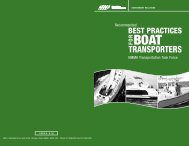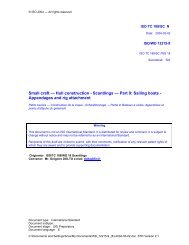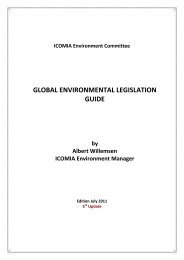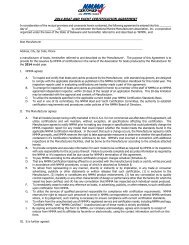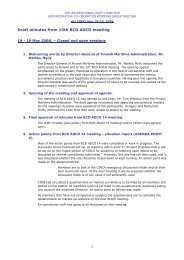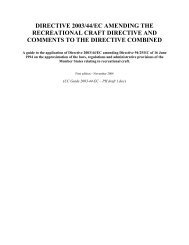Intellectual Property Protection and Enforcement Manual - Ipr-policy.eu
Intellectual Property Protection and Enforcement Manual - Ipr-policy.eu
Intellectual Property Protection and Enforcement Manual - Ipr-policy.eu
You also want an ePaper? Increase the reach of your titles
YUMPU automatically turns print PDFs into web optimized ePapers that Google loves.
Br<strong>and</strong> <strong>Protection</strong> <strong>Manual</strong><br />
where it is proven that the infringement was willful, deliberate, or malicious, the plaintiff may recover<br />
three times the defendant’s profits or its own damages (whichever is greater), as well as its reasonable<br />
attorneys’ fees. 23<br />
The Trademark Counterfeiting Act of 1984 was enacted to provide additional causes of actions <strong>and</strong><br />
remedies for injured IP owners. Under the act, courts are authorized to order the seizure of goods<br />
<strong>and</strong> counterfeit marks involved in the violation, the means of making the counterfeit marks, <strong>and</strong> the<br />
records documenting the manufacture, sale, or receipt of items involved in the violation.<br />
Trademark owners may apply to the court for such orders without notifying the adverse party (an ex<br />
parte seizure order). Nevertheless, the courts will not grant an application unless security (that is, a<br />
dollar amount adequate to cover damages the adverse party may suffer as a result of wrongful seizure<br />
or attempted seizure) is provided by the person obtaining the order, <strong>and</strong> the court finds that the<br />
facts clearly show that (1) the application is likely to succeed in showing that the person against<br />
whom seizure would be ordered used a counterfeit mark; (2) immediate <strong>and</strong> irreparable injury<br />
to the applicant will occur if seizure is not ordered; (3) harm to the applicant by denying the<br />
application outweighs the harm to the interests of the person against whom seizure would be ordered;<br />
(4) the person against whom seizure would be ordered would destroy, move, hide or otherwise make<br />
the goods in question inaccessible to the court if notified of the proceeding; (5) the applicant has not<br />
publicized the requested seizure; <strong>and</strong> (6) the items to be seized will be located at a place identified in<br />
the application. 24<br />
In 1996, the Lanham Act was further amended to provide for statutory damage awards in<br />
counterfeiting cases. Prior to 1996, courts made awards solely on the basis of a defendant’s profits or a<br />
plaintiff’s actual damages. Proving defendant’s profits or plaintiff’s actual damages, though, was often<br />
difficult, given the typical defendant’s incomplete, inaccurate, or nonexistent records. Recognizing<br />
the problem trademark owners were experiencing in proving damages in counterfeiting actions,<br />
Congress amended the Lanham Act to provide for an award of statutory damages. Plaintiffs can now<br />
elect statutory damages to recover monetary compensation while avoiding the burden of proving<br />
actual damages or the defendant’s profits. 25 A court may award statutory damages between $500 <strong>and</strong><br />
$100,000 per counterfeit mark per type of goods or services sold, but for willful use of the counterfeit<br />
mark, the court may award up to $1 million per counterfeit mark per type of goods or services sold. 26<br />
A claim for statutory damages can be a powerful tool, particularly where the conduct is egregious but<br />
the quantities involved are relatively small.<br />
Federal Criminal Trademark Laws<br />
In addition to civil remedies, federal law provides a range of criminal law sanctions for the intentional<br />
infringement <strong>and</strong> counterfeiting of federally registered trademarks. For example, the Trademark<br />
Counterfeiting Act provides up to 10 years of federal imprisonment <strong>and</strong> up to a $2 million fine, or twice<br />
the gross gain or gross loss, against a defendant who “intentionally traffics or attempts to traffic in goods<br />
or services <strong>and</strong> knowingly uses a counterfeit mark on or in connection with such goods or services.” 27<br />
Page 9



